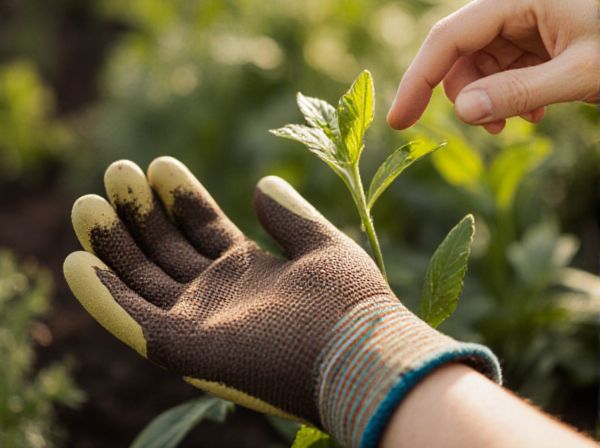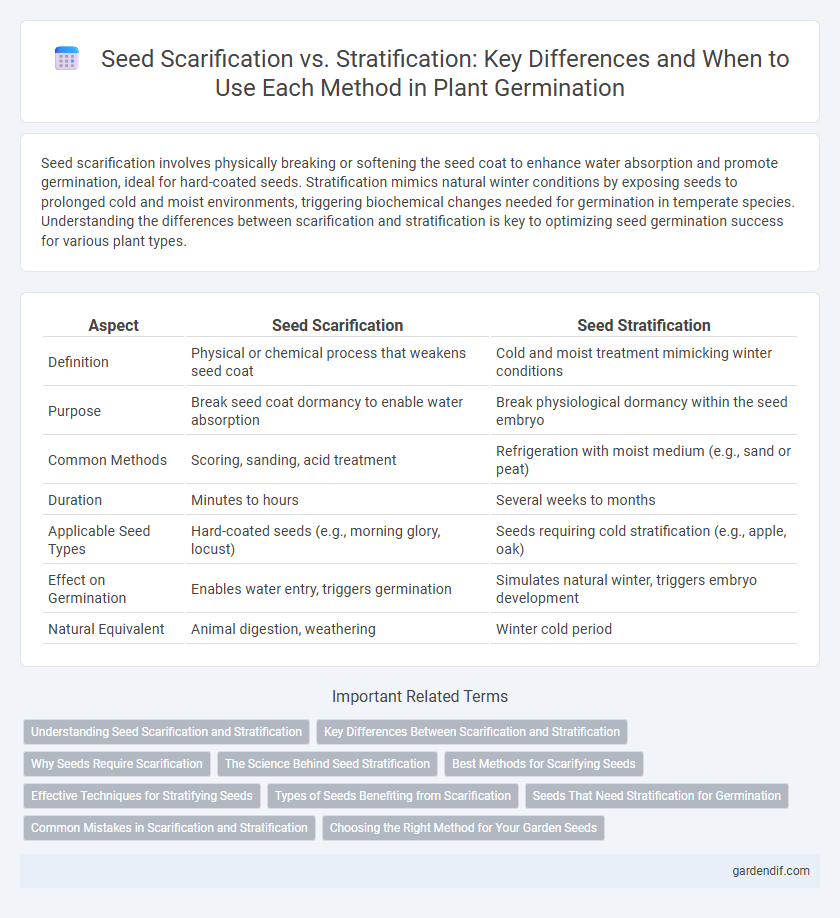
Seed scarification vs Stratification Illustration
Seed scarification involves physically breaking or softening the seed coat to enhance water absorption and promote germination, ideal for hard-coated seeds. Stratification mimics natural winter conditions by exposing seeds to prolonged cold and moist environments, triggering biochemical changes needed for germination in temperate species. Understanding the differences between scarification and stratification is key to optimizing seed germination success for various plant types.
Table of Comparison
| Aspect | Seed Scarification | Seed Stratification |
|---|---|---|
| Definition | Physical or chemical process that weakens seed coat | Cold and moist treatment mimicking winter conditions |
| Purpose | Break seed coat dormancy to enable water absorption | Break physiological dormancy within the seed embryo |
| Common Methods | Scoring, sanding, acid treatment | Refrigeration with moist medium (e.g., sand or peat) |
| Duration | Minutes to hours | Several weeks to months |
| Applicable Seed Types | Hard-coated seeds (e.g., morning glory, locust) | Seeds requiring cold stratification (e.g., apple, oak) |
| Effect on Germination | Enables water entry, triggers germination | Simulates natural winter, triggers embryo development |
| Natural Equivalent | Animal digestion, weathering | Winter cold period |
Understanding Seed Scarification and Stratification
Seed scarification involves physically or chemically breaking or softening the seed coat to enhance water absorption and promote germination in hard-coated seeds, such as legumes and certain trees. Stratification mimics natural winter conditions by exposing seeds to a period of cold and moisture, which breaks seed dormancy and stimulates germination in species like apple, cherry, and many wildflowers. Both processes improve germination rates by overcoming physical or physiological dormancy mechanisms inherent in different plant species.
Key Differences Between Scarification and Stratification
Seed scarification involves physically breaking or softening the seed coat to enhance water absorption and germination, while stratification requires exposing seeds to a period of cold and moist conditions to break dormancy. Scarification techniques include abrasion, nicking, or soaking, whereas stratification mimics natural winter chilling to trigger sprouting. Understanding these methods helps in selecting the appropriate treatment for different species to improve germination rates effectively.
Why Seeds Require Scarification
Seeds require scarification to break down their hard, impermeable seed coats that naturally prevent water and oxygen absorption, essential triggers for germination. Mechanical or chemical scarification methods mimic natural processes like soil abrasion or digestive passage through animals, making the seed coat permeable. This treatment increases germination rates by allowing vital nutrients and moisture to reach the embryo inside the seed.
The Science Behind Seed Stratification
Seed stratification involves exposing seeds to specific cold and moist conditions to mimic natural winter cycles, triggering the biochemical processes that break seed dormancy. This process activates enzymes and hormones that promote embryo development and increase germination rates. Stratification is essential for many temperate plant species that require environmental signals to ensure seedling emergence during optimal growing seasons.
Best Methods for Scarifying Seeds
Mechanical scarification, such as nicking or sanding the seed coat, effectively enhances germination by allowing water absorption in hard-coated seeds. Thermal scarification, which involves briefly exposing seeds to hot water or fluctuating temperatures, softens seed coats without damaging the embryo. Combining mechanical and thermal methods often produces the highest success rates for breaking seed dormancy in species like Lotus, Acacia, and Mimosa.
Effective Techniques for Stratifying Seeds
Stratification involves exposing seeds to cold, moist conditions to break dormancy and promote germination, typically simulated by placing seeds in a damp medium like peat moss or sand inside a refrigerator for several weeks. Effective stratification techniques vary by species, with cold stratification often lasting 30 to 90 days at temperatures between 1degC and 5degC, ensuring optimal moisture levels without causing seed rot. This method is essential for temperate plants such as apple, cherry, and pepper seeds, significantly improving germination rates compared to untreated seeds.
Types of Seeds Benefiting from Scarification
Seeds with hard, impermeable coats such as those of legumes, morning glories, and lotus benefit significantly from scarification, which physically breaks or softens the seed coat to enhance water absorption and germination. Scarification techniques include mechanical abrasion, chemical treatment, and thermal methods tailored to penetrate tough seed coverings that prevent moisture entry. This method is especially effective for species with seeds adapted to remain dormant until natural environmental conditions weaken their protective layers.
Seeds That Need Stratification for Germination
Seeds that need stratification for germination require exposure to prolonged cold and moist conditions to break dormancy and trigger sprouting. Common examples include apple, cherry, and oak seeds, which naturally undergo winter-like periods before germinating in spring. Stratification mimics these environmental cues, enhancing seed viability and promoting uniform seedling emergence.
Common Mistakes in Scarification and Stratification
Common mistakes in seed scarification include over-sanding or nicking seeds too deeply, which can damage the embryo and reduce germination rates. In stratification, failing to maintain consistent moisture levels or incorrect temperature ranges often leads to poor seed break dormancy results. Understanding species-specific requirements for both scarification and stratification is crucial to avoid these errors and ensure successful seed germination.
Choosing the Right Method for Your Garden Seeds
Seed scarification involves physically breaking or softening the seed coat to enhance water absorption and germination, ideal for hard-coated seeds like lupines and morning glories. Stratification mimics natural cold periods by exposing seeds to moist, low temperatures for several weeks, essential for temperate species such as apple and peach. Selecting between scarification and stratification depends on the seed type and its dormancy requirements, ensuring optimized germination and healthy plant growth in your garden.
Seed scarification vs Stratification Infographic

 gardendif.com
gardendif.com